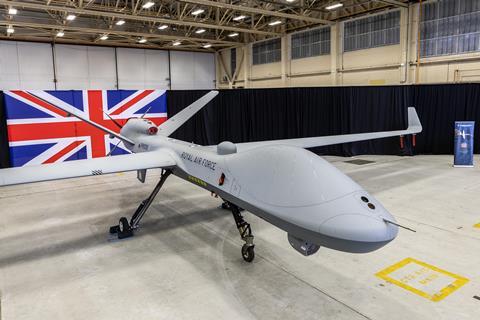The UK Royal Air Force (RAF) has taken delivery of the first of 16 General Atomics Aeronautical Systems MQ-9B SkyGuardian remotely piloted aircraft the service plans to acquire.
The RAF on 23 October said its first MQ-9B arrived at RAF Waddington in Lincolnshire, where the uncrewed type will undergo flight trials before entering service.
“The first phase of tests, beginning this week, will involve ground testing of the satellite links and taxi procedures, as well as take-off and landing trials,” the RAF says. “This will also incorporate a circuit above RAF Waddington.”
The RAF will operate the MQ-9B under the designation Protector RG1. The long-endurance platform is primarily oriented toward intelligence, surveillance and reconnaissance, but is also capable of carrying precision strike munitions.
“The Protector aircraft will bring a critical global surveillance capability for the UK, all while being remotely piloted from RAF Waddington,” the UK Ministry of Defence (MoD) says.
When the first Protector enters service in late 2024, the platform will be used for land and maritime surveillance, counter-terrorism and to provide support to civil authorities, such as assisting the coast guard with search and rescue.
The RAF’s MQ-9B fleet will be operated by the newly reformed 31 Squadron from RAF Waddington. The unit previously flew the Panavia Tornado GR4 ground-attack aircraft, which the RAF retired in 2019.
In its latest configuration, the newly assembled 31 Squadron will exclusively operate the remotely flown Protector – a model pioneered by the US Air Force for its uncrewed aircraft fleet.
The Protector will be the successor to the UK’s MQ-9A Reaper fleet, taking on the intelligence, surveillance, target acquisition and reconnaissance missions. The type will be certified to NATO safety and certification standards, according to the MoD, allowing it to operate in the UK and European civil airspace.
The RAF’s MQ-9B fleet is projected to be in full service by July 2025.




























